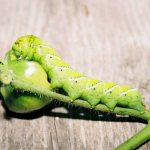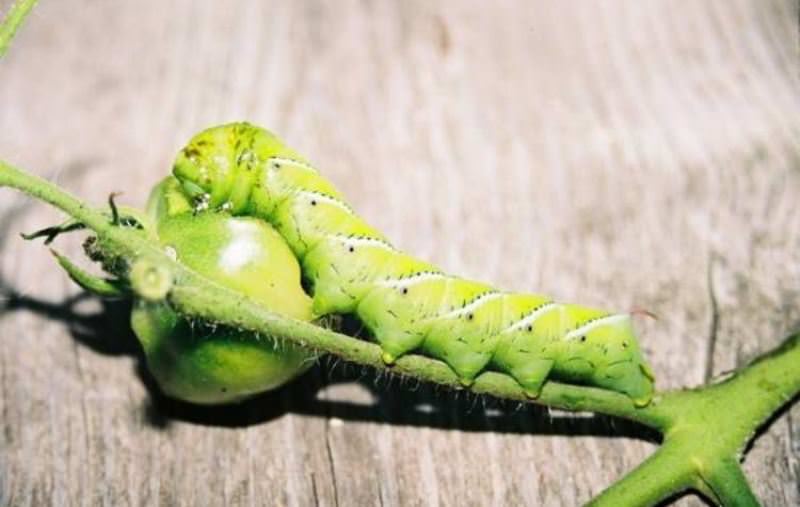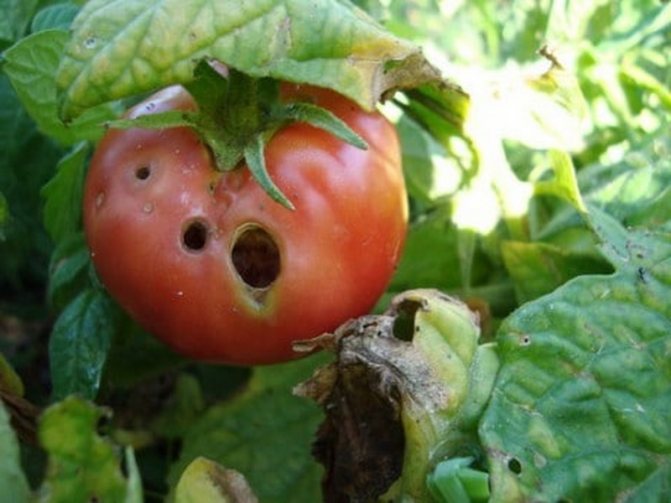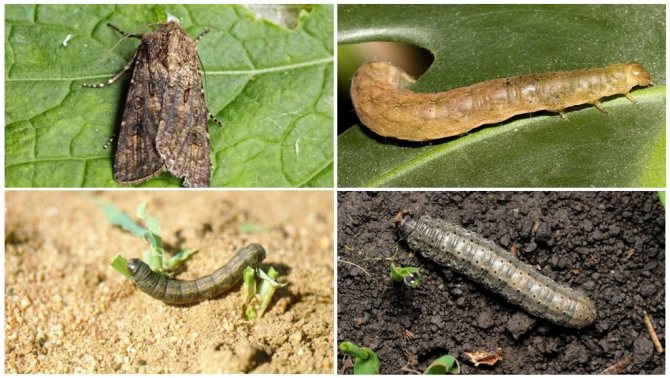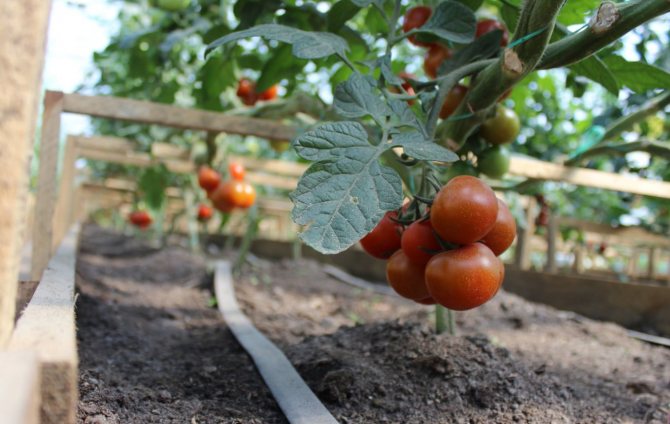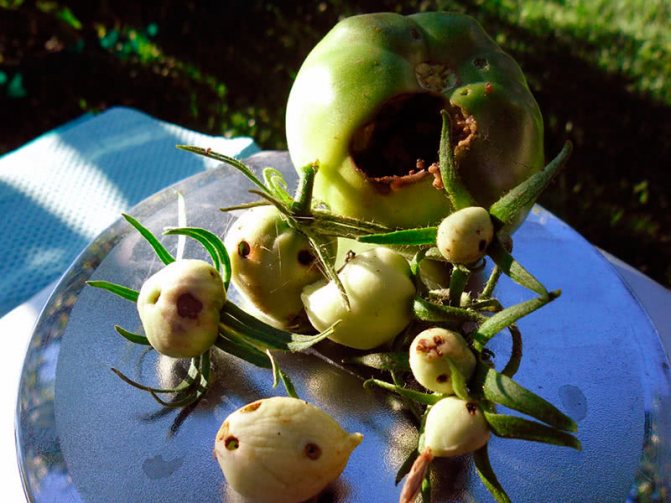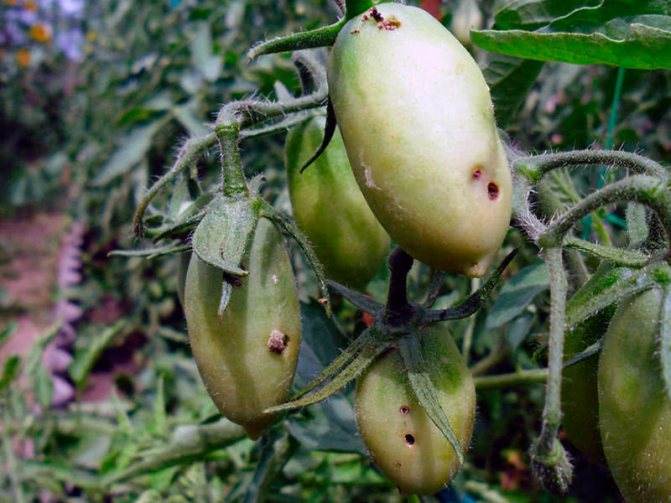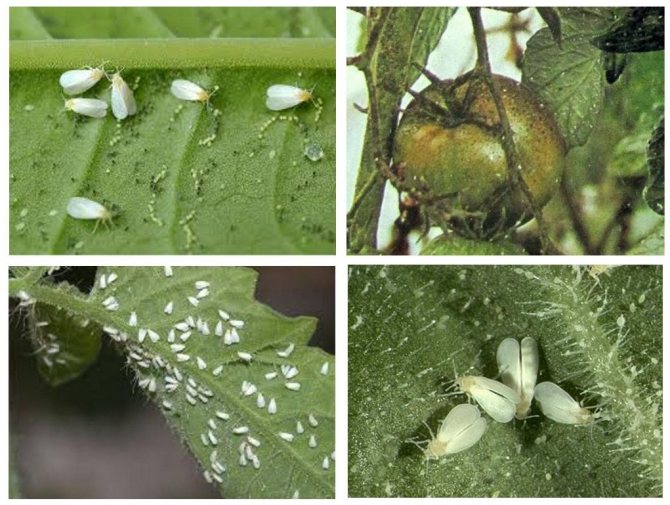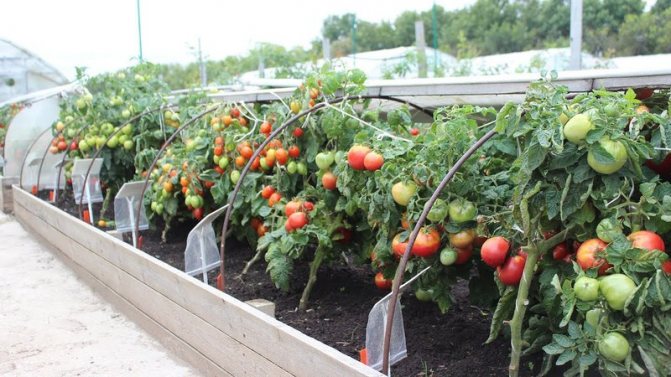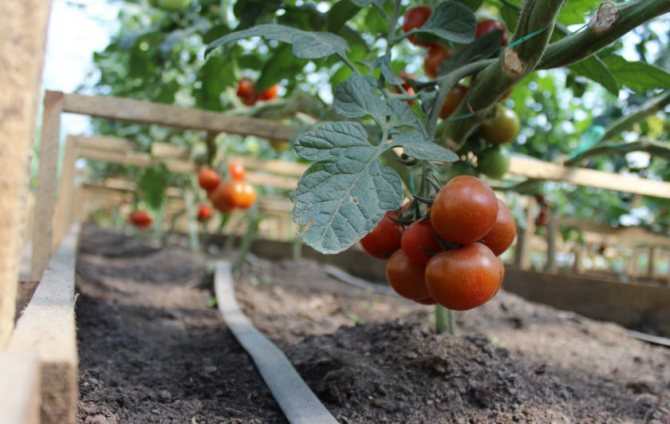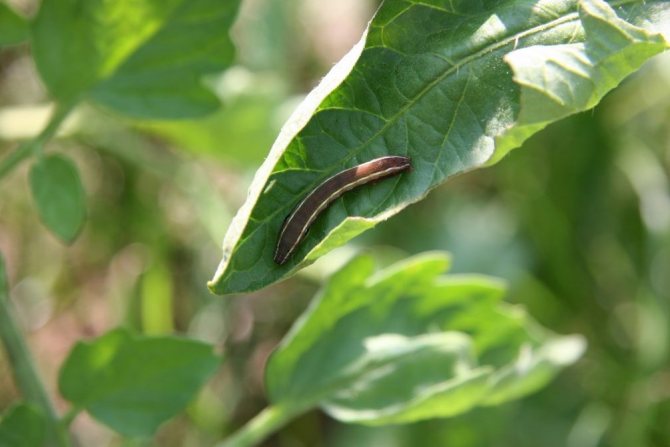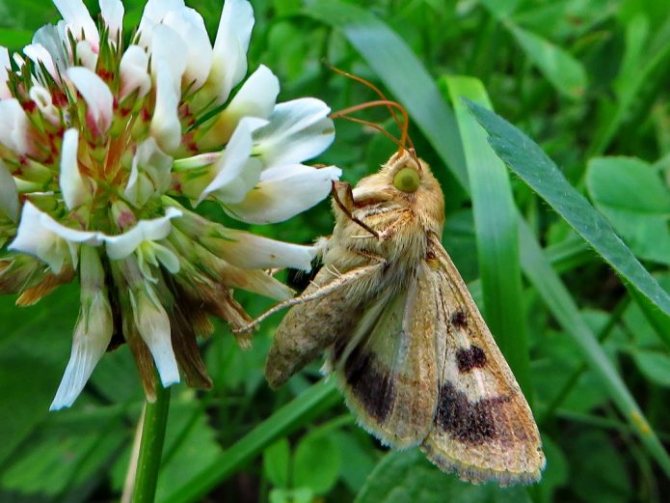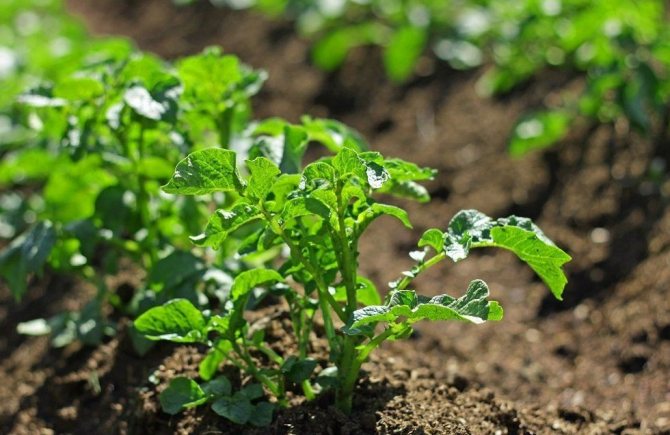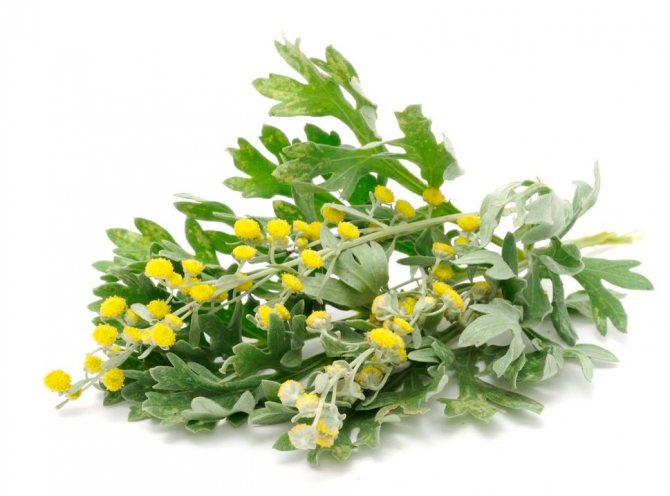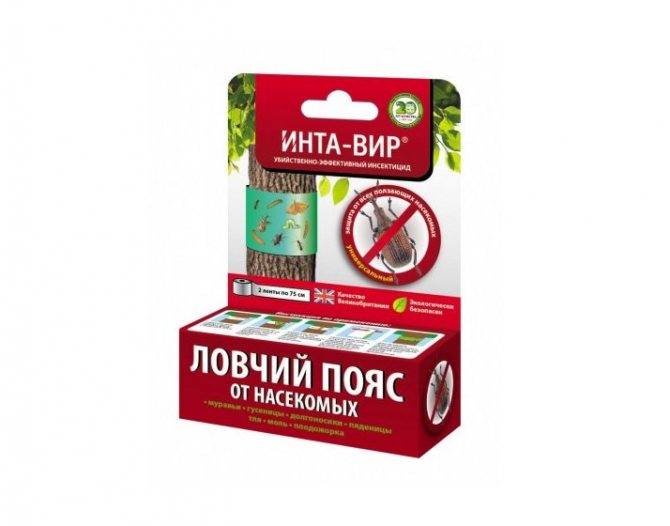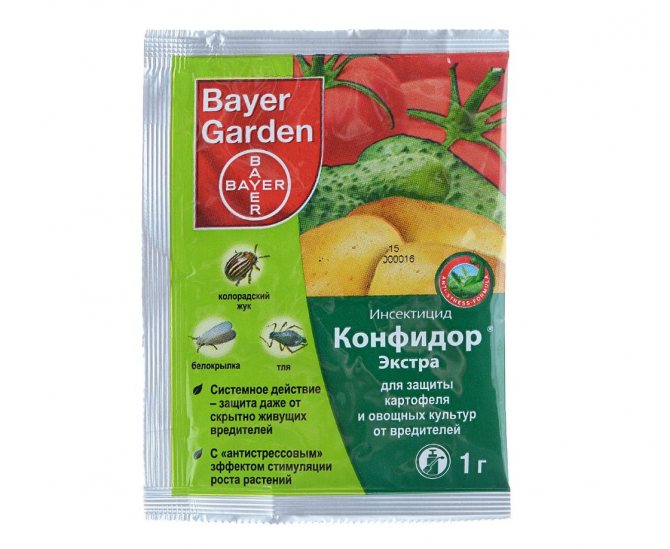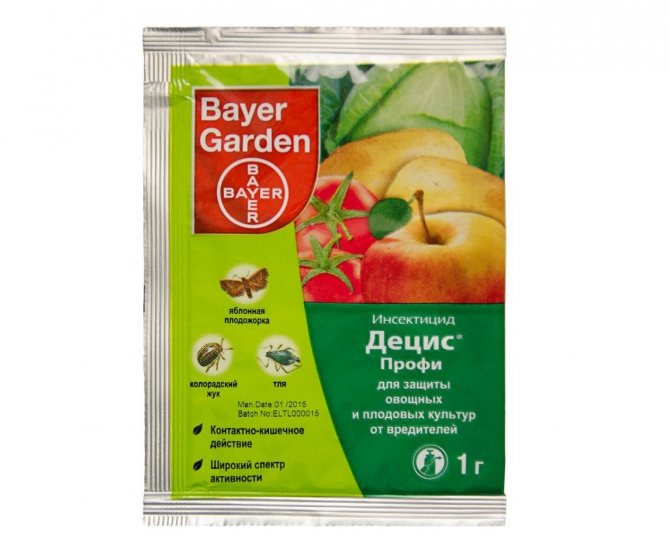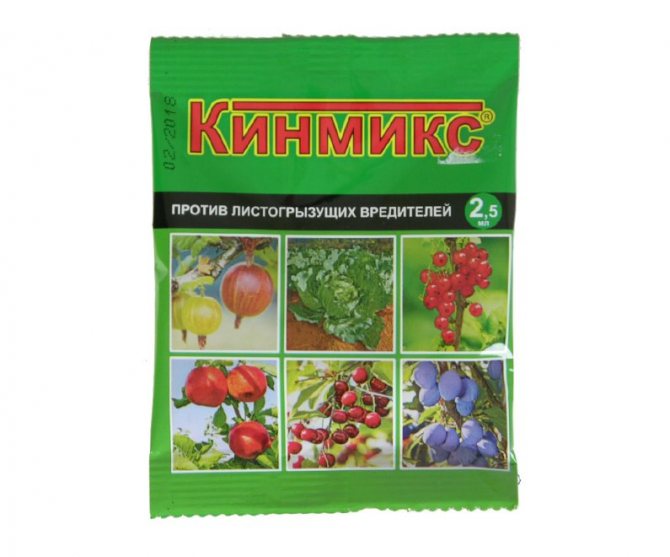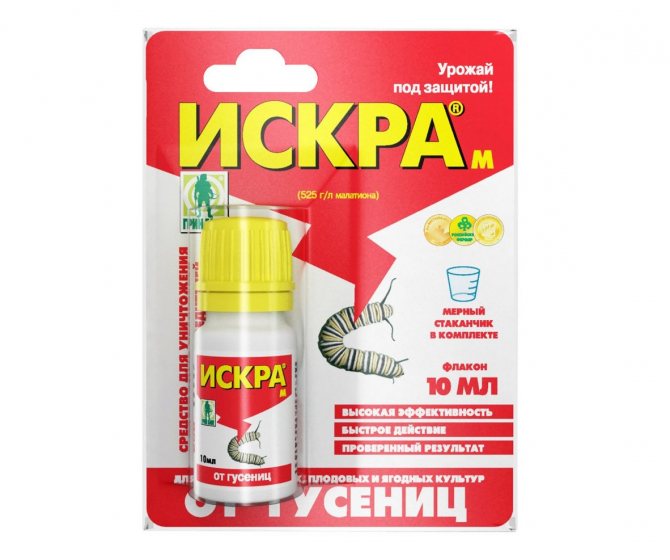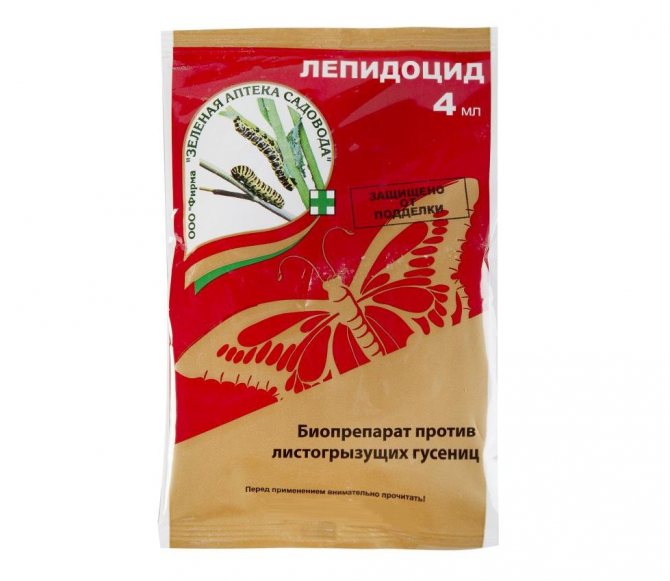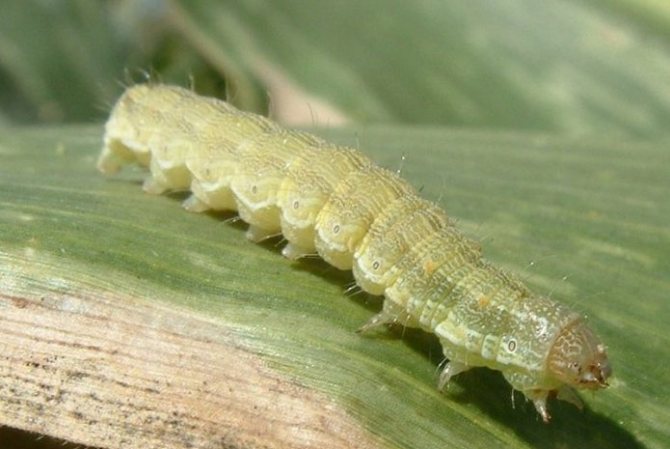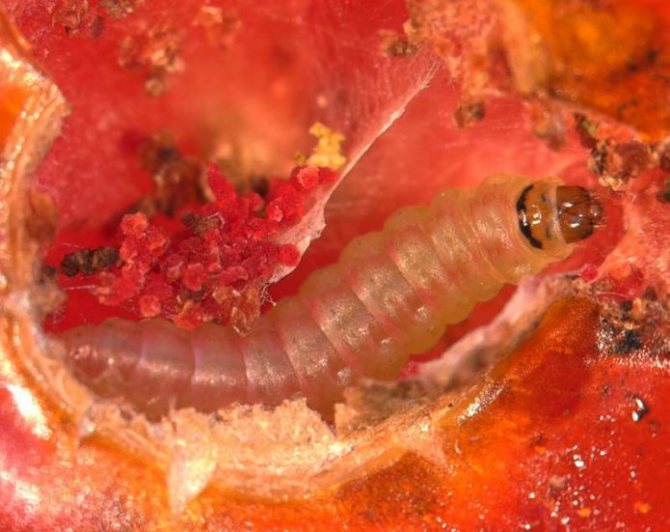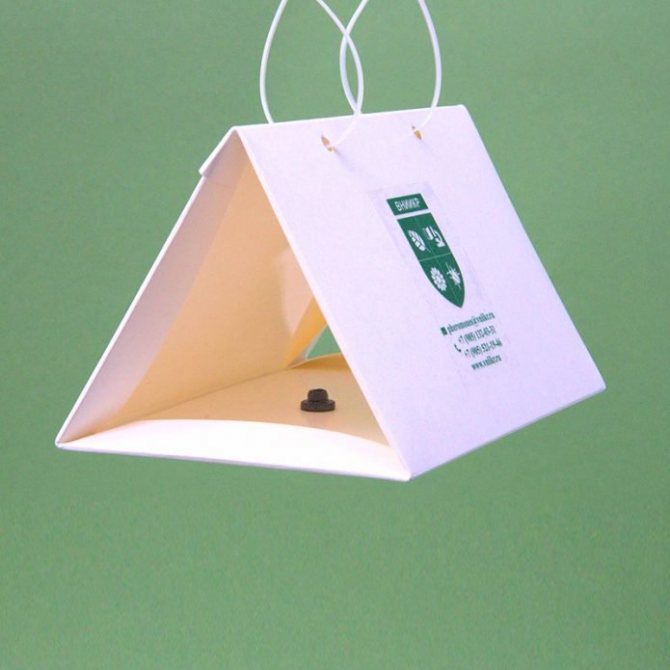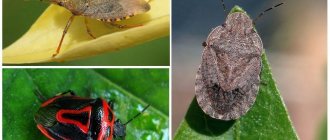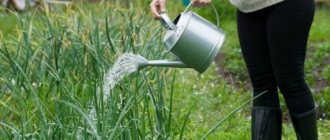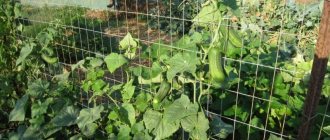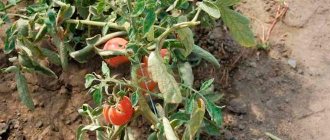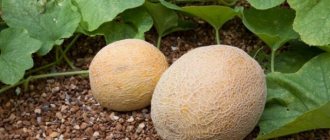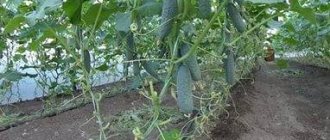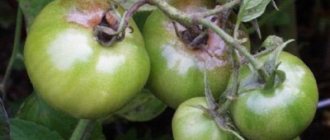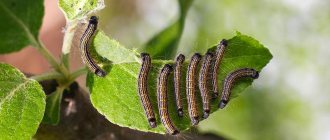Parasitic larvae in tomato beds
Not all types of caterpillars are attracted to juicy tomatoes. The larvae of two species of butterflies are most often parasitized on tomatoes - whiteflies and scoops. They actively eat the fruits and leaves of the plant. You can encounter pests not only in the open field, but also in the greenhouse. The larvae are not the only danger. Butterflies damage tomatoes as they carry bacteria and viruses. Due to insects, plants begin to hurt.
This manifests itself in different ways:
- tomatoes stop growing;
- the fruits of tomatoes are deformed;
- the yield decreases due to the absence of the ovary.
Whiteflies and scoops can harm more than just tomatoes. They fly over to neighboring vegetable crops. Insects are dangerous for squash, eggplant and bell peppers.
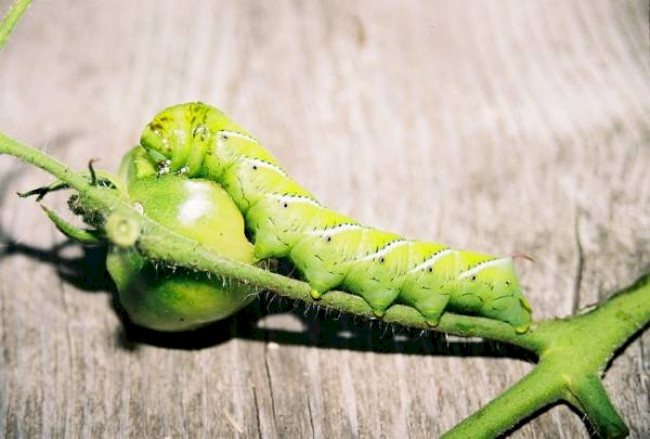
Whitefly larvae
It is difficult to notice the pest on plant leaves. The size of the whitefly is only 1.5-3 mm. The body of a butterfly is white or yellowish, the wings are completely snow-white. An insect does not fly alone. Usually dozens of butterflies sit on a branch. To find them, you need to shake the trunk of the plant. Whiteflies will fly upward, forming a white cloud.
Insect larvae are initially transparent, with a greenish tint. They feed on the sap of the plant and live on the inside of the leaves. During the cycle, the caterpillar goes through several stages. Young larvae are very mobile. They move constantly, destroying healthy and succulent leaves. Caterpillars secrete a sticky secret that contains a lot of sugar. Because of this, the plant becomes infected with a sooty fungus.
The foliage is covered with black bloom, which slows down the processes of photosynthesis. Not receiving the proper amount of sunlight, the plant gradually dies. Caterpillars on tomatoes spoil not only the foliage, but also the fruits. Tomatoes are covered with a white bloom.
The liquid emitted by the caterpillars of the whitefly attracts ants to the territory. These insects can bring aphids to the site, which can cause enormous harm to immature tomatoes.
When the caterpillar is ready to turn into a butterfly, it slows down. The body of the insect is covered with a waxy coating. Instead of a transparent color, it becomes light green. A green caterpillar on tomatoes in a greenhouse is resistant to chemicals. Treatment of tomatoes with pesticides and insecticides during this period will not bring results. The wax cover will protect the caterpillar from poisonous compounds.
Whiteflies should be feared at high humidity and air temperatures above 10 degrees. Caterpillars and butterflies die at the beginning of frost. But whitefly eggs survive in cold weather. Butterflies lay them in the upper layers of the soil, where the insect can stay until the next season.
Whiteflies live not only on tomatoes. Caterpillars can eat many houseplants:
- begonias;
- fuchsia;
- balsams;
- passionflower;
- pelargonium.
They pose a danger to potato beds and greenhouse peppers.
Moth larvae
The butterfly is a small nondescript gray moth. The wingspan of the insect is less than half a centimeter. Butterflies lay their eggs in the ground. Two weeks are enough for the larvae to emerge from them. The life cycle of a caterpillar before turning into a butterfly is 40 days. During this time, it causes significant damage to the crop.
The scoops are not only dangerous for tomatoes.Caterpillars eat cabbage, beans, beets, rutabagas and eggplants beds.
The moth larvae, depending on the subspecies, may differ in color. Most caterpillars are green. There are individuals in a brown-pink color. Their length does not exceed 30 mm.
The caterpillar eats the tomatoes from the inside. It moves in tomato stems and also feeds on leaves. When the plant begins to wilt and the greens cease to be fleshy, the insect moves to the fruit. The gnawing subspecies of the scoop is a danger to the root system of the plant. They can feed on underground stems.
The moth caterpillar must be fought during the larva's release from the egg. It is impossible to calculate this period in advance. After the caterpillar is born, there are several days during which it can be seen on the plant. Then the caterpillar gnaws at the stem of the tomatoes, making it very difficult to see it.
Exclamation scoop
Let's begin to consider who the scoops are, with such a representative as an exclamation scoop. Its other name is exclamation bat.
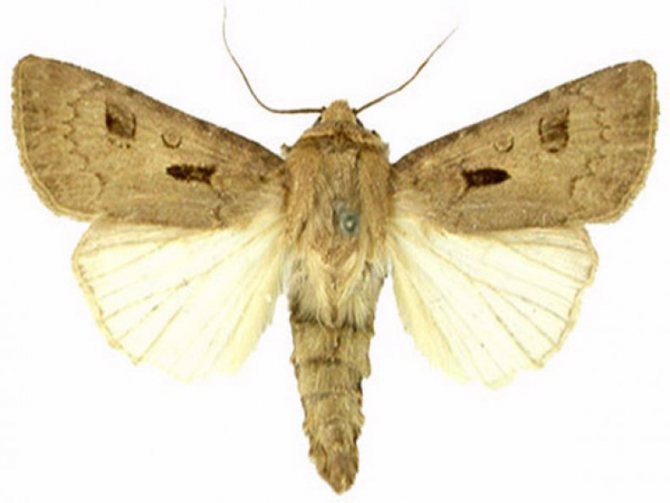

What does it look like and what harm
A small butterfly with yellow-gray or brown-gray wings. On the wings it has a longitudinal black stripe, similar to an exclamation mark. This feature gave the name to the butterfly. The wingspan is 3.5-4.6 cm.
The caterpillar is yellow-brown, with a white line on the back and dark stripes on the sides. The butterfly itself is harmless. But the caterpillar devours the fruits and plants on which it lives - potatoes, tomatoes, sunflowers, all vegetables, especially carrots. Caterpillars spend most of their life in the ground and damage plant roots. One individual is capable of damaging 10 plants per night. The larvae, which appear in August-September, feed on winter crops.
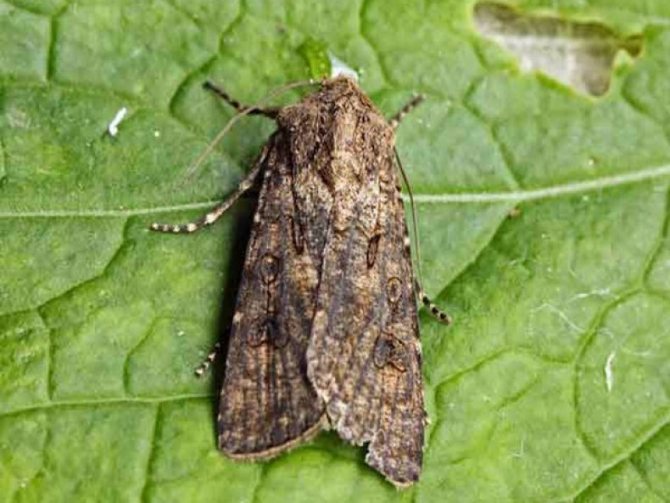

Read also: Ways to remove trees
How to fight
The basis of the struggle is to choose folk and traditional methods:
- weeding of row spacings and weed control;
- the use of pheromone traps and bowls with baits (jam, beer);
- in the fall, when digging - the collection and destruction of scoop caterpillars;
- during the flight of butterflies, spraying with insecticides ("Decis", "Eurodim", "Akiba") helps.
Reasons for the appearance
Plants should be examined especially carefully for the presence of pests in several cases:
- Humid climate. Heavy rains and hot air are ideal weather for the eggs to hatch. The soil in which the masonry is located becomes warm enough, which becomes a signal for insects.
- Abundance of fruit crops. If there are territories with vegetable gardens and orchards near the suburban area, the likelihood of the appearance of caterpillars is high. Butterflies move quickly through the air and conquer new territories.
- Weed grass. Weeds during the flowering period attract pests to the site.
- Poor soil treatment. Butterfly eggs are laid in the ground. To destroy the masonry, you need to dig up the top layer of soil. The minimum processing depth is 15 cm.
A fine-grained insect net will help get rid of caterpillars in the greenhouse. She will not let butterflies inside, which will protect plants from pests.
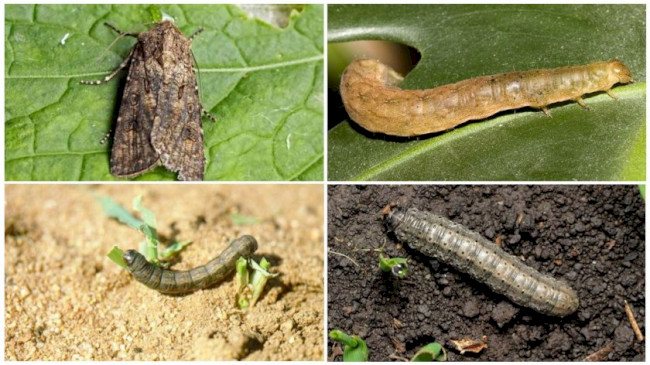

Scoop - photo and fight against it on tomatoes, potatoes and cabbage
Scoops - small cute faded butterflies , resemble house moths, there are different types in nature. And they do no less harm. True, they do not eat wool and household products, but plants in the garden. Adults do not damage crops, but hatch caterpillars - the main danger to crops.
If you want to preserve your harvest - start destruction activities and preventing the appearance of this pest. Scoop up measures to combat it further.
External manifestations of caterpillar activity
You can notice that pests have appeared on tomatoes by several signs:
- The leaves of the tomatoes are covered with a white bloom.
- Holes appear in green fruits.
- The foliage turns black, dries quickly and falls off.
- Tomatoes turn dark brown and fall off the branches.
- White and gray butterflies fly over the tomatoes at night.
You can check for caterpillars on the site using a butterfly trap. An ordinary plastic bottle with a narrow neck is suitable for its manufacture. A sweet fermented liquid is poured inside. Kvass, jam or berry compote will do. The trap is set at night. If in the morning there are several pest butterflies inside the jar, parasitic caterpillars have settled on the tomatoes.
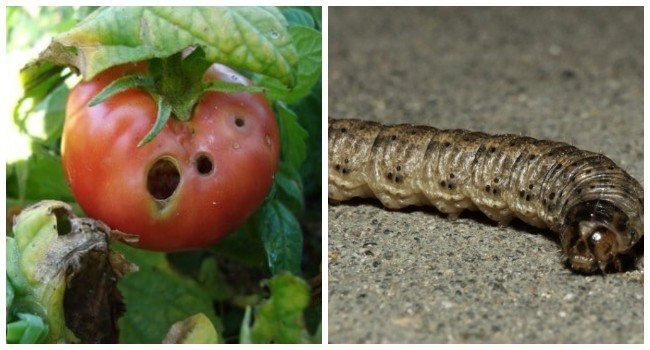

Potato scoop
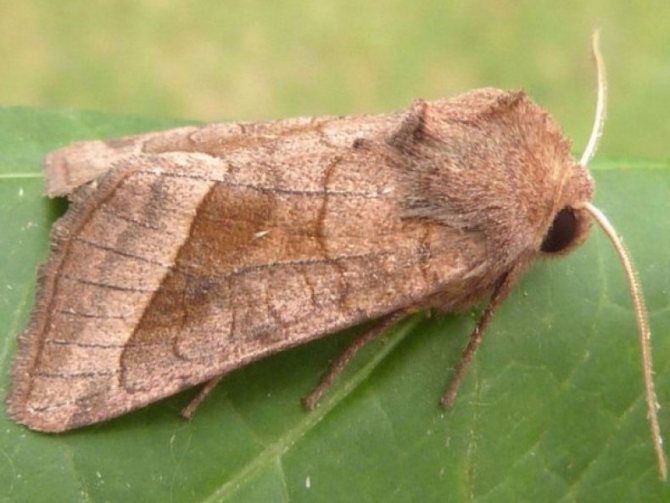

This species of butterflies considers potatoes, tomatoes, carrots to be the basis of their nutrition, but they also do not disdain other vegetables and cereals.
What does it look like and what harm
Brown-gray butterfly with a wingspan of up to 4 cm. Caterpillars are red-brown, similar to May beetle larvae, but smaller. It is the larvae that cause harm. They hatch in early spring and eat holes inside the stems, tubers of plants. They damage the roots and ovaries of early plants.
How to fight
General methods of struggle help well - autumn plowing, hilling of plants, processing of row spacings, destruction of weeds (especially cereals) and spraying with insecticide ("Decis", "Eurodim", "Akiba").
How to spray tomatoes from pests?
There are several ways to deal with caterpillars on tomatoes. With the help of insecticides, you can get rid of pests in one treatment. But it is dangerous to use chemicals during the ripening period, as the poison can get into food. If the first tomatoes appear on the plant, it is worth using folk methods. They are not as effective, but they are safe for humans.
Chemical insecticides
Treatment with toxic substances is carried out in case of emergency. It is advisable to resort to potent drugs when pests threaten most of the crop.
Effective insecticides against caterpillars include:
- Inta-Vir. The drug can be used no more than 2 times per season.
- "Decis". The advantages of this remedy are fast action and lack of habituation in insects. Can be used once a season during the active growth of tomatoes.
- "Avant". Processing should be carried out during the growing season of plant growth. It is recommended to water the site with the drug once a year. "Avant" destroys not only caterpillars, but also eggs of butterflies in the ground.
- Aktara. The drug is effective against one hundred species of insects. It poisons not only caterpillars, but also other common pests - aphids and the Colorado potato beetle.


Insecticides are removed naturally from the plant 30 days after spraying. It is not recommended to use them during the period when tomatoes are bearing fruit.
One drug is not suitable for annual treatment. Insects quickly become immune to chemical compounds.
Organic preparations
Bio-based insecticides can be used multiple times per season. They are safe for humans, do not poison fruit crops and do not cause addiction to insects.
Organic preparations for plant protection against caterpillars include:
- "Lepidocide". It scares away butterflies and quickly kills caterpillars.
- Aktofit. During the season, two treatments are carried out with this product for optimal results.
- "Biostop". Effective against scoops and aphids.
- Fitoverm. For optimal results, the site is treated with the product twice during the spring and summer period.
- "Verticillin". The drug is made on the basis of a fungus toxic to insects. It quickly destroys butterflies and whitefly caterpillars.
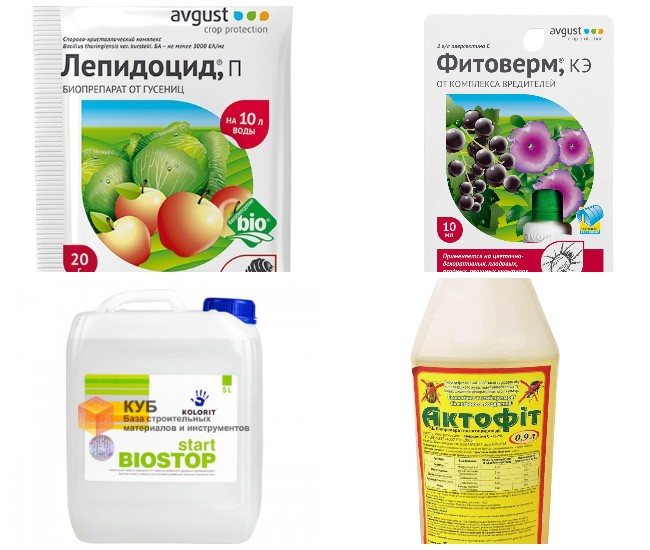

Tomatoes after treatment with bioinsecticides can be harvested in a few days.
Folk recipes
With the help of available tools, you can prepare an effective solution against pests. Spices have deterrent properties. Such as salt or mustard.You can also reduce damage from caterpillars by poisoning the pests with a concentrated herbal infusion.
Saline solution
To prepare the mixture, 400 g of sodium chloride is dissolved in 5 liters of water. Leaves are treated with the composition, both from the outside and from the inside. To keep the salt on the surface of the plant longer, you can add shavings from laundry soap to the mixture.
Mustard powder solution
Pour dry mustard into boiling water. A bucket of water uses 100 g of powder. The solution is infused for 48 hours. Then they can be sprayed with infected plants.
Wormwood decoction
For 1 liter of boiling water, there are 100 g of chopped weed. The broth is infused for 2 days. The resulting concentrate must be diluted with water in a ratio of 1:10.
Infusion of tobacco
300 g of tobacco dust is poured into one bucket of boiling water. The solution is infused for a day. To make it last longer on the leaves, you need to add a third of the lumpy laundry soap to the infusion.
Garlic water
Garlic is harmful to caterpillars. For the solution, it is necessary to grind 700 g of the arrows of the plant and fill them with hot boiled water. The broth is infused in a sealed container for a week. For a bucket of water, you need to use 50 g of concentrated infusion. The product can be sprayed on tomatoes every 10 days.
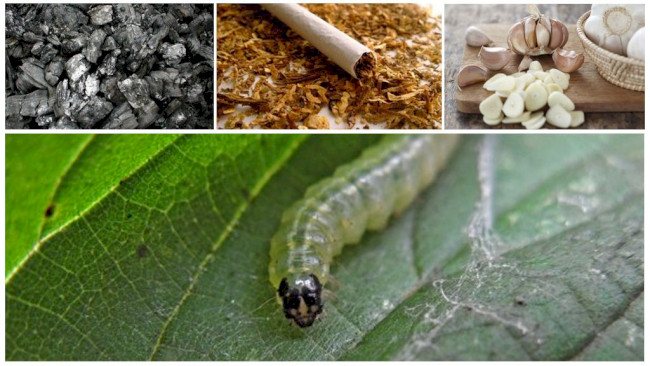

Garden scoop
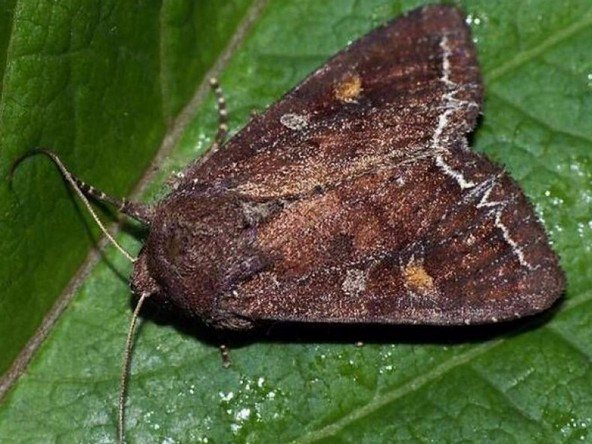

As the name implies, the garden scoop is a garden pest butterfly.
What does it look like and what harm
Red-brown butterflies with transverse lines on the wings. Caterpillars 3 cm long devour the leaves and pulp of cabbage, tomatoes and more than 40 crops.
How to fight
Good help:
- catching with baits;
- manual collection of pests;
- weed control;
- hilling plants and processing row spacings;
- spraying with insecticides ("Decis", "Eurodim", "Akiba").
It is better, of course, that the fight against scoops by folk methods is combined with chemical treatment.
What plants scare away caterpillars?
Insect pests will avoid places where bird cherry bushes grow. Many useful and medicinal plants scare away caterpillars:
- mint;
- calendula;
- coriander;
- sage;
- thyme;
- thyme.
Butterflies are afraid of strong odors. The scoop and whitefly are repelled by some types of flowers, such as geraniums, cornflowers and marigolds.
Advice! In early spring, white mustard seeds can be planted in future tomato beds. When the plant sprouts, it will saturate the ground with its scent. After that, the soil is loosened, tomato seedlings are planted. Butterflies will not be able to lay eggs in such soil.
Varieties
There are a large number of scoop varieties, the most famous of them are:
- Cabbage scoop, which harms oil, fruit, legumes and vegetables.
- Garden scoop that infects cabbage, rutabagas, tomatoes, legumes.
- A winter moth that damages field grasses.
- Pine scoop. It harms conifers.
- The gamma scoop reproduces where flax, potatoes, beets, corn, and legumes are grown.
Biological methods
In nature, the enemies of pest caterpillars are trichograms. They lay their eggs in butterfly cocoons, thereby destroying garden pests. Insects can be purchased at a specialty store. They are released on tomato bushes 3 times per season. For 1 hectare of land, 5000 trichograms must be planted.
Poaching is a danger to caterpillars. These are predatory flies that parasitize the larvae of other insects. Females pierce the caterpillar's cover and inject poison, which stops the digestive system from working. Then the adult introduces about 20 larvae into the victim's body. The dragons eat the inside of the caterpillar until they reach maturity.
Heart scoop
The heart scoop, like the potato scoop, is a rather serious pest of root crops.
What does it look like and what harm
The wingspan is 3-4 cm, the wings are brownish-yellow in color with transverse stripes.Caterpillars are dirty brown. After hatching, the caterpillars bite into the plant stems. The plant dries up and breaks down, 3-5 caterpillars can coexist on one plant. These butterflies are especially fond of parasitizing on nightshades - potatoes, tomatoes, etc.
How to fight
The fight against scoops on tomatoes and potatoes is carried out by manually collecting caterpillars and weeding. Weed control, plowing and inter-row cultivation prevent larvae from emerging. Butterflies can be caught using pheromone traps or bowls of water and molasses.
Read also: Secrets of growing celosia: planting seedlings and care in the open field
How to properly handle tomatoes?
Proper tomato care reduces the risk of caterpillars in the area. Plant processing methods differ depending on the location where the fruit crops are located.
Outdoors
Larvae can infect the soil when planting seeds that have parasites. To prevent this from happening, you always need to process the seedlings. The solution for disinfection is prepared on the basis of potassium permanganate. For 1 liter of water, 1 mg of the product is used. The seeds are placed in the solution for 15 minutes. Then they are thoroughly washed. Then they can be germinated or dried and used later.


To cope with the caterpillars on the site will help dusting the soil with tobacco dust. Butterfly eggs will die in it, due to which the population of larvae will decrease. If few insects are seen, it is worth spraying the leaves with herbal infusion. You can wash off the sticky sweet bloom every other day, which is secreted by the larvae of several species. Thus, it is possible to protect the plant from the formation of fungus.
In case of massive insect infestation, it is worth using organic or chemical preparations for processing.
In greenhouses and hotbeds
Many butterfly traps can be set in a closed area. Fly tape can help reduce the number of insects. You can also spread sheets of plywood or boards, smeared with a sticky and sweet solution, in a greenhouse.
It is only possible to get rid of caterpillars in the greenhouse completely thanks to insecticides. It is important to follow the instructions when processing so as not to exceed the allowable amount of chemicals.
Scoop-gamma
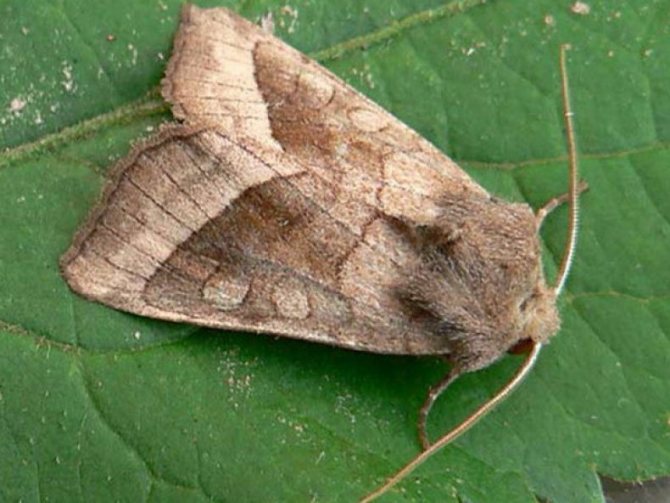

A widespread insect. It parasitizes more than 95 plant species.
What does it look like and what harm
Insect with a wingspan of 4–5 cm, earthy-brown in color. On the wings there is a light spot in the form of the Greek letter gamma. Larva 4 cm long, green with three pairs of pseudopods. Refers to leaf-eating pests. They live on cereals, beets, and other vegetables.
How to fight
To fight, use conventional insect control methods - plowing in the fall, loosening, processing row spacings, traps with molasses. In case of strong dominance of butterflies - insecticides ("Decis", "Eurodim", "Akiba").
Scoops - numerous and active pests.
Gluttonous caterpillars destroy plants almost overnight. But the fight against them is possible and will bring results. Combining proper care and the use of folk methods, coupled with chemicals, will preserve your harvest.
Helpful hints and tips
It is undesirable to plant tomatoes too close to each other. Because of this, it is convenient for pests to move to neighboring plants, and their population is growing rapidly.
Tomatoes need daily watering. The land must be moistened moderately so that a favorable breeding environment for caterpillars is not created. Tomatoes are watered early in the morning, when the sun has not yet had time to warm the earth. Water should be poured only under the root of the plant. It is also advisable to water the soil in winter. Because of this, the pupae of insects that are in the ground die.
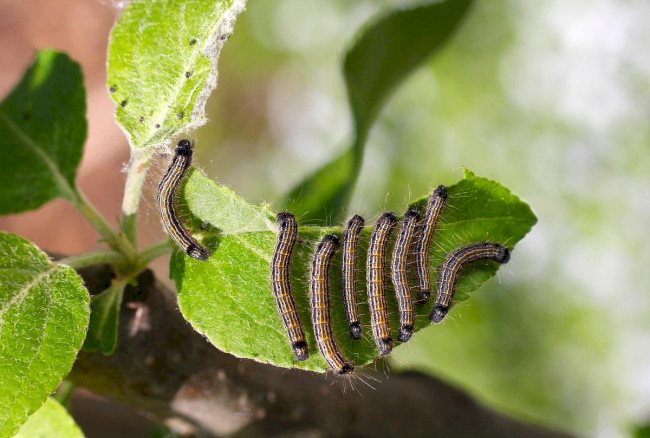

Winter scoop
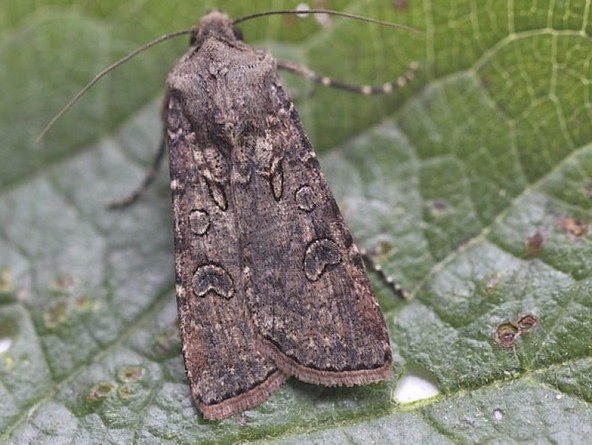

It looks like an exclamation scoop.
What does it look like and what harm
A grayish-brown butterfly measuring 3-5 cm (with open wings). On the wings there is a pattern of stripes and spots.Caterpillars develop in loose soil, in heated areas. Weeds and volunteers provide refuge for developing caterpillars. Harm a huge amount of vegetables and grains. The roots of plants gnaw at the stems, especially beets, sunflowers, and cereals.
How to fight
The winter moth is no different from other butterflies in this family, and the control measures should be the same. Weed control, winter plowing (to kill larvae), early sowing of beets, sunflowers and other crops - these standard methods for killing such insects are applicable to winter control. You can also add insecticide spraying and the use of natural enemies of scoops - trichograms, which lay their eggs in their caterpillars.
Prevention measures
To prevent larvae from growing on the site, you must carefully monitor the seedlings. The likelihood of the appearance of parasites is small if:
- the top soil of the earth is completely replaced at the end of autumn;
- in spring, the soil is treated with boiling water or a weak solution of potassium permanganate;
- there is no weed in the garden;
- greenhouse windows are protected with fine-grained mesh;
- in the fall, tomato tops are completely removed from the site.
The invasion of caterpillars can be easily stopped if measures are taken in time and the fruit plants are processed. Timely prevention will help reduce the number of pests on the site.

